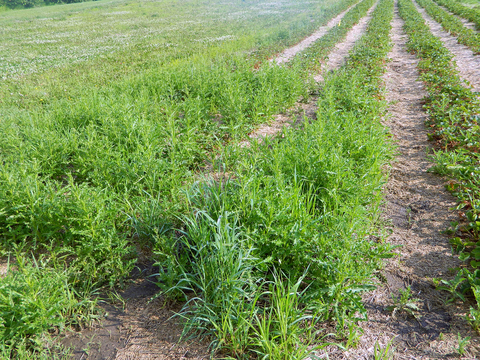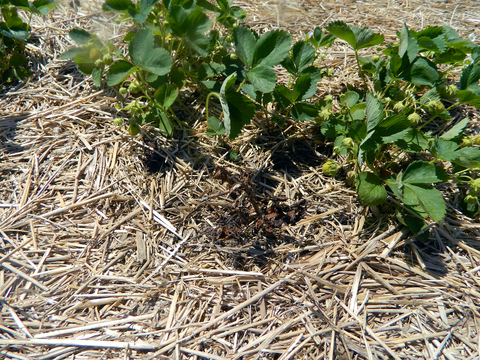Key points
- Reduce perennial weed pressure before planting strawberries.
- After strawberries are planted, manage weeds by integrating physical, cultural, and chemical (if applicable) strategies.
- The recommended weed management strategies depend on the time in the season, the production system (June-bearing vs. day-neutral), and overall farm practices (organic vs. conventional).
- If herbicides are used, be careful to only use labeled herbicides at appropriate times in the strawberry growth cycle, spot spraying when feasible to reduce herbicide injury.
In most areas of the Upper Midwest, weeds cause more economic losses in strawberry crops than diseases and insect pests.
Weeds reduce strawberry yield and attract insect pests and disease. So they must be managed throughout the lifetime of the strawberry bed, from pre-planting through the final harvest.
Weed control is one of the most labor-intensive tasks in strawberry production, especially on organic farms where herbicides are not used.
Day-neutral strawberry weed management, while still labor-intensive, is less arduous than in June-bearing systems because of the use of plastic mulch and landscape fabric.
Strawberry Farming - Managing Weeds (03:44)
Timeline for weed management in strawberries
- Before planting: Winter cover crops, cultivation, flaming, stale seedbed, pre-emergent herbicide (if applicable)
- Planting year - summer: Cultivation, flaming, hand-weeding, spot-spraying
- Production years - early spring: Cultivation, pre- and post-emergent herbicide
- Late spring through harvest: Hand-weeding, string trimming (day-neutral)
- Renovation: Mowing, hand-weeding, pre- and post-emergent herbicide
- Fall: Hand-weeding, herbicides
Hand-weed in late spring to clean up any weeds missed by fall and early spring herbicide treatments. If winter annual weeds become established and flower by late spring, they will contribute to weed problems later in the summer.
Weed management before planting
Eliminating perennial weeds prior to planting is crucial. It is harder to control them once the strawberry plants are growing. Use a combination of crop rotation and solarization for maximum perennial weed control.
- Rotate strawberries with annual crops like pumpkins, corn, sunflowers, and grains. This introduces tillage, weed competition, and alternative herbicide options to the system.
- Soil solarization can be very effective on perennials like thistles and dandelions. It involves heating the soil by covering it with a clear plastic tarp for 4 to 6 weeks during a hot period of the year when the soil receives the most direct sunlight. Research at the UMN Cornercopia Student Organic Farm also found that used vinyl billboards are highly effective at smothering Canada thistle when applied for 4 to 6 weeks during the summer.
- If needed, use labeled post-emergent herbicides on perennial weeds based on recommendations in the Midwest Fruit Pest Management Guide.
- Extend control measures beyond the immediate area of the planting site since perennial weeds are known for their ability to spread over great distances.
Weed management in established plantings
For best results, combine weed management strategies into an integrated program rather than relying heavily on one practice.
Post-planting weed management options
- Cultivation
- Hand-weeding
- Straw mulch (June-bearing) plastic and/or landscape fabric (Day-neutrals)
- Inter-row cover cropping (Day-neutrals)
- Herbicides
Organic weed management options
Straw mulch between the rows provides some, but not total, weed control. Hand-weeding is an important part of organic weed control. University of Minnesota researchers have conducted research on ways to make organic weed management easier.
Stale or false seedbed technique
The stale or false seedbed technique is an option in day-neutral strawberries and June-bearing strawberries in the planting year.
- It involves flushing out weed seeds from the soil before a crop is planted, depleting the weed seed bank before planting strawberries.
- It can be done shortly before planting in the spring, or throughout the year before planting.
- First, cultivate the soil in the spring to stimulate weed seed germination.
- Following cultivation, the emerging weeds are either killed by flaming or by another cultivation.
- This technique may need to be repeated numerous times the year before planting to reduce the seed bank and perennial weeds.
Flame weeding
- Flame weeding is usually not possible in either June-bearing or day-neutral strawberries due to the presence of highly flammable straw, plastic, cover crops, or landscape fabric throughout the life of the planting.
- The only exceptions would be in newly planted fields, or day-neutral strawberries where bare soil is maintained between the rows rather than landscape fabric or cover crops.
- It is most useful for annual weeds, and weeds must have fewer than two true leaves for this method to be effective.
- Grasses are harder to kill by flaming because the growing point is below ground.
- The efficacy of flaming for perennial weed species is largely unknown.
Cover crops and landscape fabric
UMN has conducted day-neutral strawberry research on organic land to compare the use of cover crops and landscape fabric between rows.
Cover crops can provide numerous benefits for soil health, and some species can help suppress weeds. However, in this trial, landscape fabric provided more complete weed control and higher yields than annual cover crops.
One Minnesota farmer involved in this research says he has switched from cover crops to landscape fabric to decrease the need for string trimming, which uses fossil fuels and involves a lot of labor.
But the soil health benefits of between-row cover crops may encourage other growers to plant them. Growers must weigh these options to make the best decision for their particular farm.
Weeder geese
Weeder geese have been used for weed management in a large number of crops for many years. At Michigan State, researchers studied the impacts of populations of domestic geese and chickens in a non-chemical orchard system.
- They found that geese fed heavily on weeds and preferred grasses.
- If the geese are confined they will dig up and eat Johnsongrass and bermudagrass rhizomes.
- Because of concerns regarding microbial contamination from their waste, weeder geese should only be used during the non-bearing stage of strawberries and should be removed from the field at least 90 days prior to harvest.
Herbicides
For growers using herbicides, a number of products are labeled for use in strawberries. Choose herbicides based on the time of season and the growth stage of the plants, as many products can injure the plants if they are applied while the plants are actively growing.
- In addition to the time of the season, also base herbicide choices on the weeds present, to ensure that the products used are effective on those weeds.
- Make use of labeled pre-emergent herbicides in the spring and after harvest to reduce the need for post-emergent herbicide application and hand-weeding.
- 2,4-D amine is labeled for application to strawberry rows during renovation when the strawberry plants are not actively growing.
- Use the Midwest Fruit Pest Management Guide (MFPM) for guidance on herbicide selection. Use tables in the guide to select herbicides based on efficacy on weed species, time of season, and other factors.
Why we don’t list herbicide options: The MFPM guide is updated bi-annually, and is the most up-to-date resource for this information specific to the Midwest. We do not have the capacity to update this webpage bi-annually, or the space to provide complete product information.
Reducing herbicide injury
- Reduce product usage and lower the risk of herbicide drift by spot-spraying individual weeds such as dandelions and thistles rather than spraying the whole field.
- While commonly used herbicides such as glyphosate cannot safely be applied directly over the strawberry plants, it can be spot-applied to kill stubborn weeds near the rows.
- Avoid using 2,4-D in strawberries except during renovation and according to label instructions.
- Do not use dicamba or 2,4-D in areas adjacent to the field as they are highly susceptible to volatilization and will injure strawberries.
Noelle Orloff, Jane Mangold, Zach Miller, Fabian Menalled. A meta-analysis of field bindweed (Convolvulus arvensis L.) and Canada thistle (Cirsium arvense L.) management in organic agricultural systems. Agriculture, Ecosystems & Environment, Volume 254, 2018, Pages 264-272, ISSN 0167-8809. https://doi.org/10.1016/j.agee.2017.11.024.
Reviewed in 2021



